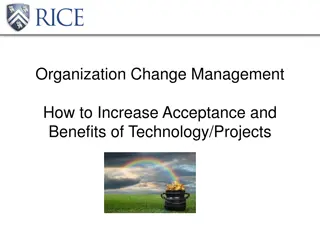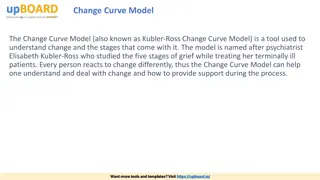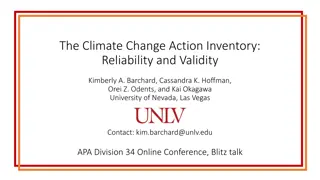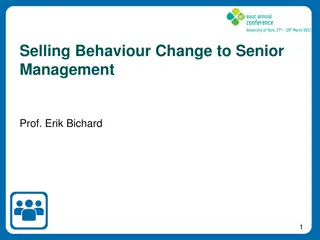Optimizing Building Performance Through Post-Occupancy Modeling
Explore the benefits of post-occupancy performance modeling in assessing and enhancing energy efficiency in buildings. Follow a case study of the One New Change project in London, showcasing strategies like model calibration, ECM assessment, and continuous improvement for energy conservation and occupant comfort. Utilize data collection, monitoring, and analysis to identify opportunities for optimizing building operations and energy efficiency.
Download Presentation

Please find below an Image/Link to download the presentation.
The content on the website is provided AS IS for your information and personal use only. It may not be sold, licensed, or shared on other websites without obtaining consent from the author.If you encounter any issues during the download, it is possible that the publisher has removed the file from their server.
You are allowed to download the files provided on this website for personal or commercial use, subject to the condition that they are used lawfully. All files are the property of their respective owners.
The content on the website is provided AS IS for your information and personal use only. It may not be sold, licensed, or shared on other websites without obtaining consent from the author.
E N D
Presentation Transcript
FAST AND ROBUST BUILDING SIMULATION SOFTWARE Calibrated Energy Models: One New Change London, UK
For most buildings, there is a performance gap between actual and predicted usage: Actual usage Simulated usage >> (kWh/ year) (kWh/ year)
Real buildings are subject to natural variations in weather, occupant behavior, and other factors Measured data Predicted input data
Can we employ post-occupancy performance modelling to close the performance gap? = Actual usage Simulated usage (kWh/ year) (kWh/ year)
Case Study: One New Change project This project set out to assess potential benefits of post-occupancy performance modelling. This strategic activity encompasses building energy modelling, post-occupancy monitoring, model calibration, energy conservation measure (ECM) assessment, and a continuous cycle of adjustment and improvement. EDSL worked alongside industry partners on this project funded by Innovate UK, a government-backed initiative to foster productivity and economic growth through business-led research, development, and implementation. The project consisted of analysing a mixed-use retail/ office building located near St Paul s Cathedral in London. The team sought to identify opportunities to optimize energy efficiency without sacrificing occupant comfort or building services.
Building Operations Data was collected from the facility while in operation. A weather station was installed on the building s roof to capture conditions as accurately as possible. Utility bills, metering data, O&M data and BMS system data provided a complete picture of the overall loads, usage patterns, and performance drivers. BMS screen grabs Utility bills Metering data Onsite weather station O&M data
Plant Room Model Retail unit s HPs Retail condenser loop GSHPs Office boilers Condenser loop boilers DAC Office FCUs and AHU heating Office chillers Office FCUs and AHU cooling Ground loops
Office Airside Model Typical AHU and FCU system diagram
Overall Simulated Performance Billing data vs simulation Gas and electricity billing information was supplied for the July 2015 - June 2016 time period. There were two billing anomalies in the data: No gas information for June, and January s consumption included data from a prior month. Including the two anomalies, peak monthly error = 12.2% (Jan 2016), and average annual error = 5.5% Total simulated annual energy cost: 1,778,084 1,602,217 175,866 grid-supplied electricity natural gas Total simulated cost is within 2.5% of billed cost, with the difference being mainly on gas. This cost will be used to calculate savings on energy conservation measures. Monthly Energy Consumption (MWh) Tas simulation actual
Detailed Simulated Performance Whilst the overall simulated performance matches well with the actual performance, good agreement was also found in the detailed performance of individual components and process. A few of these will be highlighted: Retail condenser loop temperature Ground loop temperature Office humidity control
Detailed Simulated Performance Retail condenser loop temperature (C ) Due to high heat rejection from the retail units in the summer months the condenser loop temperature reaches a peak of ~44 C. The simulated peak is ~42 C at the same time of year. The shape of the variation in condenser loop temperature is identical for monitored and simulated data. This is because the observed weather data is being recorded on-premises and is used within the Tas model. Monitored Data Heat is extracted from the condenser loop by the dry air cooler (DAC). Simulated in Tas
Detailed Simulated Performance Ground loop temperature Spikes and drop-outs may be ignored One New Change s ground loop uses 13 ground-source heat pumps (GSHPs) to supply heating and cooling to the retail and office systems. Total simulated annual energy cost: 1,778,084 These graphs show monitored flow temperature from the ground loop to the GSHPs from mid- August to the end of 2015. Monitored Flow Temp 1,602,217: grid-supplied electricity 175,866.50: natural gas The simulated temperature is shown for the last 6 months of 2015. Total simulated cost is within 2.5% of billed cost, with the difference being mainly on gas. This cost will be used to calculate savings on energy conservation measures. Simulated Flow Temperature
Detailed Simulated Performance Office humidity control The as-commissioned office humidity control was based on supply air absolute humidity being maintained within a range of 5.3g/kg and 6.3g/kg. It resulted in office humidity being below 40% for long periods through the year and even below 30% for a significant time. Office humidity during occupied hours - supply air control Simulations suggested that control of return air absolute humidity between 7.3g/kg and 8.9g/kg would make a significant improvement in office humidity levels. This strategy has been implemented and office space conditions have improved as predicted. Besides the improvement in occupant well being, the change in control strategy is predicted to save 61,550 per year. Office humidity during occupied hours - return air control
Further Office Comfort Improvement and Energy Savings There are two main issues with the office fan coil unit (FCU) operation affecting comfort and energy consumption: hunting , due to too small a FCU deadband setting, and local difference in thermostat control settings (as set by occupants). These issues are modelled by by setting an overlapping control band on heating and cooling for the FCU. The design engineers strategy is to re-set the thermostat setting and increase the deadband by 0.5 C to 1 C. typical hunting behavior After being implemented in the Tas model, the results showed an energy saving of 150,000 and a significant improvement in occupant comfort. This aspect of the project has been important in prompting the development of more advanced FCU modelling to account for the effects of poor deadband control and setpoint variations.
Additional Performance Improvements Ground loop optimization Selecting an optimum control strategy for controlling ground loop temperature is non-trivial, due primarily to the variation in heat pump performance. Office humidity during occupied hours with supply air control Tas GenOpt can be used to perform a parametric study optimizing setpoint and size of control band. The table below gives an indication of the best approach. Starting with a base case of 16 C setpoint and a band of 27 C, the following table shows the percentage energy reduction (or increase) for each alternative. Setpoint ( C) 10 13 16 19 22 0.00% 27 Office humidity during occupied hours with return air control Band ( C) 3.14% -0.85% 0.87% 10 41.55% 49.82% 47.10% 42.82% 45.63% 0
Conclusion Case Study: One New Change project This project demonstrated the benefit of post-occupancy performance modelling. The One New Change project was able to improve system performance and occupant comfort, leading to significant operational cost savings and potential gains in occupant productivity and well being. Additional use cases for similar studies include proforma analyses for potential projects, in order to calculate projected rates of return on improvements or new construction projects. One New Change, for example, would have yielded a 20% ROI solely from existing systems optimization. As demonstrated, Tas dynamic simulation engine is well suited for performing such studies due to its innovative capabilities in creating unique plant room and airside systems and the accuracy of its simulations. Tas offers integrated data and systems inspection, quick, easy-to-use data visualization tools, and transparent, easy access to data for use in other applications.























